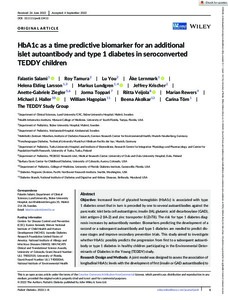HbA1c as a time predictive biomarker for an additional islet autoantibody and type 1 diabetes in seroconverted TEDDY children
Salami Falastin; Tamura Roy; You Lu; Lernmark Åke; Larsson Helena Elding; Lundgren Markus; Krischer Jeffrey; Ziegler Anette-Gabriele; Toppari Jorma; Veijola Riitta; Rewers Marian; Haller Michael J.; Hagopian William; Akolkar Beena; Törn Carina; TEDDY Study Group
https://urn.fi/URN:NBN:fi-fe2022110164010
Tiivistelmä
Objective
Increased level of glycated hemoglobin (HbA1c) is associated with type 1 diabetes onset that in turn is preceded by one to several autoantibodies against the pancreatic islet beta cell autoantigens; insulin (IA), glutamic acid decarboxylase (GAD), islet antigen-2 (IA-2) and zinc transporter 8 (ZnT8). The risk for type 1 diabetes diagnosis increases by autoantibody number. Biomarkers predicting the development of a second or a subsequent autoantibody and type 1 diabetes are needed to predict disease stages and improve secondary prevention trials. This study aimed to investigate whether HbA1c possibly predicts the progression from first to a subsequent autoantibody or type 1 diabetes in healthy children participating in the Environmental Determinants of Diabetes in the Young (TEDDY) study.
Research Design and Methods
A joint model was designed to assess the association of longitudinal HbA1c levels with the development of first (insulin or GAD autoantibodies) to a second, second to third, third to fourth autoantibody or type 1 diabetes in healthy children prospectively followed from birth until 15 years of age.
Results
It was found that increased levels of HbA1c were associated with a higher risk of type 1 diabetes (HR 1.82, 95% CI [1.57-2.10], p < 0.001) regardless of first appearing autoantibody, autoantibody number or type. A decrease in HbA1c levels was associated with the development of IA-2A as a second autoantibody following GADA (HR 0.85, 95% CI [0.75, 0.97], p = 0.017) and a fourth autoantibody following GADA, IAA and ZnT8A (HR 0.90, 95% CI [0.82, 0.99], p = 0.036). HbA1c trajectory analyses showed a significant increase of HbA1c over time (p < 0.001) and that the increase is more rapid as the number of autoantibodies increased from one to three (p < 0.001).
Conclusion
In conclusion, increased HbA1c is a reliable time predictive marker for type 1 diabetes onset. The increased rate of increase of HbA1c from first to third autoantibody and the decrease in HbA1c predicting the development of IA-2A are novel findings proving the link between HbA1c and the appearance of autoantibodies.
Kokoelmat
- Rinnakkaistallenteet [27094]
